Home Cured Bacon
This crispy and smoky homemade bacon recipe blows anything store-bought out of the water. I'll show you how to make bacon from scratch using a simple curing and smoking method that's easier than you think!
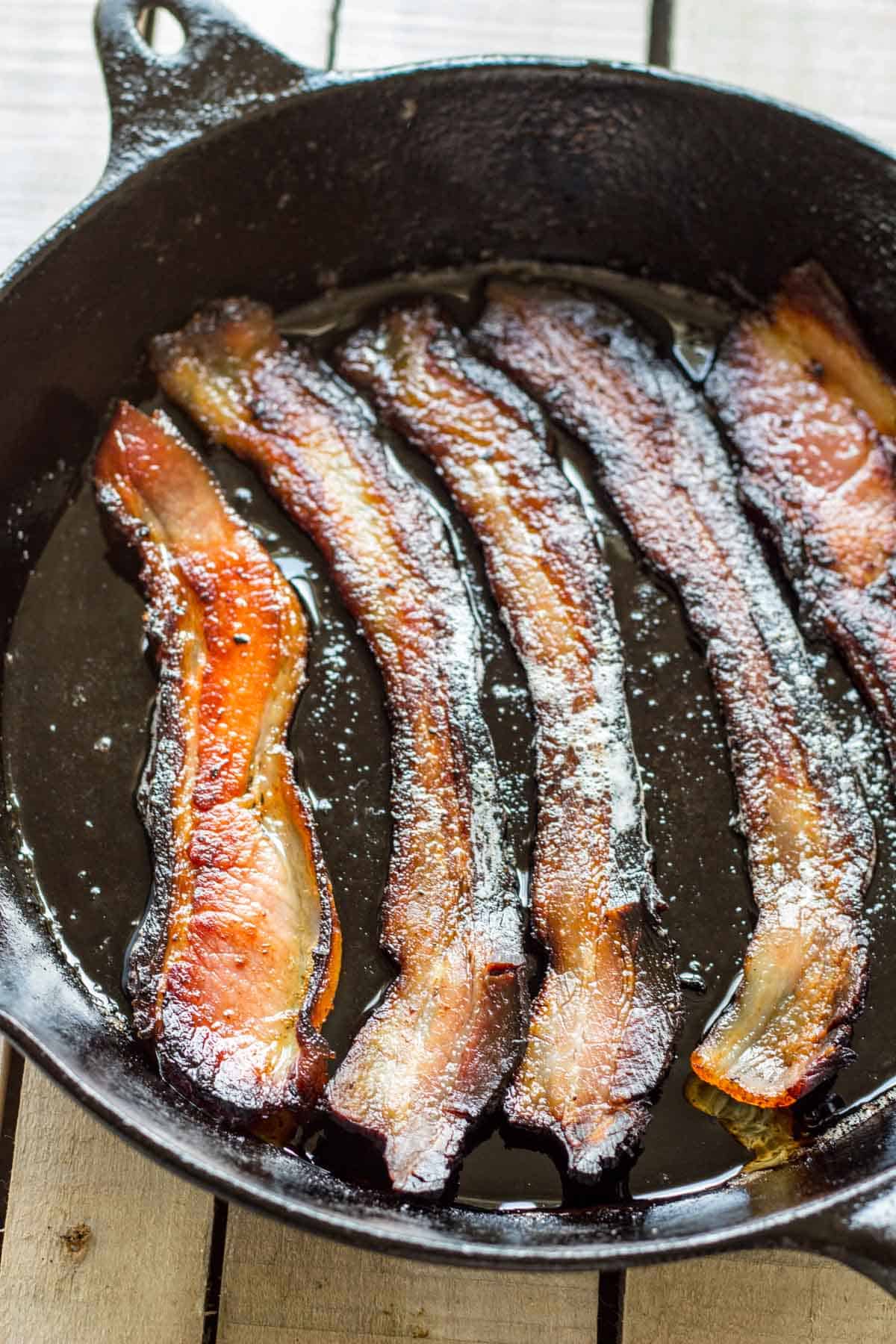
Making Your Own Smoked Bacon is Game Changing
Learning to make DIY bacon from scratch is absolutely worth your time. You get to control every ingredient, and the end result is unlike anything you can get at the grocery store.
It's deeply flavorful, perfectly textured, and infused with that unmistakable smoke flavor. Plus, it's fun!
This recipe will guide you through sourcing the ingredients, the curing process, smoking, slicing and cooking your own homemade bacon so it turns out perfect every time.
If you love a fun cooking project, you have to give this a try. Once you taste your own, there’s truly no going back!
Cured vs Uncured Bacon
Curing is the process of preserving meat by using a combination of salt, sugar, and sometimes nitrates or nitrites. This not only prevents spoilage and food safety risks in uncooked cured meats, but also transforms the product's flavor, texture, and color. When it comes to bacon, curing is what gives it that distinct savory, salty taste and firm bite we all expect.
Bacon marketed as “uncured” is a bit misleading, because technically all bacon is cured. That's what makes it bacon! How it's cured is what makes the difference.
Traditional cured bacon, and most commercial bacon brands, uses sodium nitrate and sodium nitrite (often in the form of pink curing salt or Prague Powder #1) for preservation and that classic pink color. This is a processed product that is seen as less natural nowadays. “Uncured” bacon, on the other hand, skips synthetic nitrites and instead uses sources like celery juice powder, which still contain small amounts of naturally occurring nitrates.
Making your own bacon lets you choose your curing method. This recipe uses pink curing salt for flavor, safety, and that classic cured look—but it’s totally under your control.
How long does Smoked Bacon take to make?
Start to finish, this process takes about 7–9 days, including the curing period and smoking process, but most of that is inactive, hands off time. The refrigerator does most of the hard work. he process of dry curing needs rest—and the end result is absolutely worth it. The biggest challenge is to be patient and wait!
Want more bacon recipes? Try my sweet and crispy candied brown sugar bacon, this hearty black bean soup with bacon and beer, or a truly satisfying BLT sandwich made with thick-cut slices of streaky bacon.

Why This Recipe Works
- Brown sugar and maple syrup create a balanced cure with depth and gentle sweetness.
- Applewood smoke adds cleaner, more complex flavor compared to oven roasting.
- Pink curing salt gives proper preservation, true bacon flavor and signature color.
- Freezes well with no loss of texture or taste.
- Easily adaptable to your favorite seasonings and dry rub flavor combinations.
Homemade Bacon Recipe Ingredients
Pork Belly – Look for pork bellies at a local butcher, specialty shop, Asian market or from local farmers. If it comes with the skin and bones still attached, you’ll need to remove them first. Choose a piece of pork belly with a good balance of meat and fat. A whole belly gives you better control over thickness and slicing. You can also do this same process with pork loin to make Canadian bacon.
Pink Curing Salt (Prague Powder #1) – Essential for traditional bacon flavor and texture, pink curing salt helps preserve the meat and gives it that distinct cured pink color. Yes, this is the nitrate, but it's used in very small amounts, and no it cannot be replaced with Himalayan pink salt or regular salt. Use absolutely no more than the amount called for.
Kosher Salt – Balances the sweetness and is essential for the bacon cure. A good general rule is to use a kitchen scale for precise measurements.
Brown Sugar – This adds sweetness to balance the salt and helps develop color and flavor during cooking. Light or dark brown sugar both work.
Honey or Maple Syrup – Adds depth and complexity. You can adjust based on your taste preference.
Black Pepper – Gives the bacon a touch of spice and rounds out the seasoning. Make sure it's freshly cracked black pepper. Feel free to add any other spices of your choice for an even tastier bacon.
Applewood Chips – Used during smoking to infuse the bacon with a sweet, mild smokiness. Feel free to experiment with other wood chips, like cherry wood or hickory, depending on what you like.
*Find the full ingredient list in the recipe card below!
Helpful Equipment
- 2-gallon zip-top plastic bag or a vacuum sealer bag
- Smoker (charcoal, electric, or pellet)
- Large cutting board
- Sharp slicing knife or long serrated knife
- Instant-read thermometer
- Wire rack
- Plastic wrap or freezer bag
How to Make Bacon
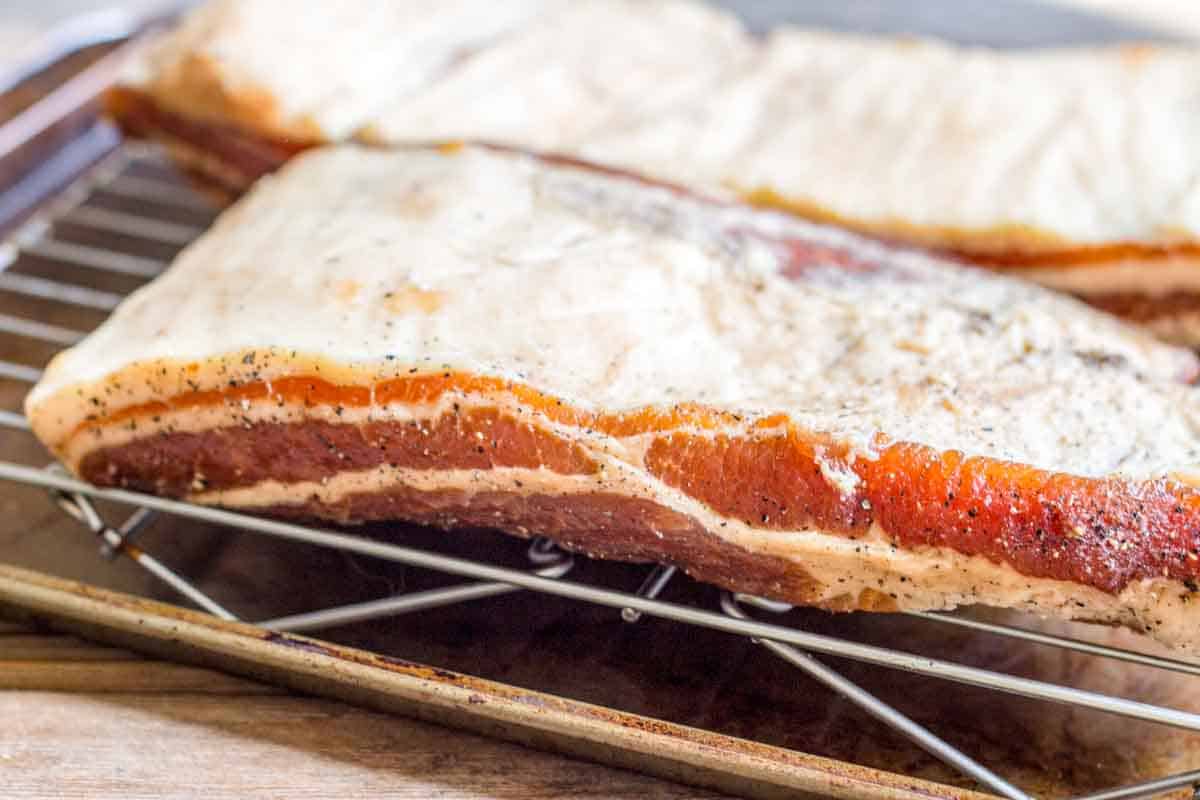
How to Cure Bacon
- In a small bowl, combine the kosher salt, pink curing salt, brown sugar, maple syrup or honey, and black pepper. Mix the cure ingredients to form a cohesive dry cure mix, then add it to a 2-gallon ziplock bag along with the pork belly.
Pro Tip: Weigh the size of the pork belly and calculate the exact amount of cure by percentage for consistent results and food safety. Excess cure can make the bacon overly salty.
- Massage the cure mixture into all sides of the pork belly, being sure to coat the fat side and all edges. Press out the air, seal the bag, and refrigerate for 7 days in a cool place. Flip and massage the bag once a day to help the cure penetrate evenly.
- After the curing period, the pork should feel firm to the touch. Rinse the pork belly thoroughly under cold water and pat it very dry with paper towels. You really want to rinse it for a long time to make sure all the excess salt is removed.
Pro Tip: At this point, you can place the meat on a rack or meat hook and leave it uncovered in the fridge for several hours or overnight. This forms something called a "pellicle," which helps the meat absorb smoke and retain its moisture. However, it's optional, and I usually skip it because I don't really notice a difference in smoke flavor or moisture.

How to Smoke Bacon
- Prepare your smoker with applewood chips and preheat to 225°F. Place the cured pork belly on a wire rack, fat side up, and smoke for 2–3 hours until the internal temperature reaches 165°F.
- Let the finished product cool completely, then wrap in plastic wrap or a freezer bag and refrigerate overnight. This makes it way easier to slice the next day.

How to Slice Homemade Bacon
Chill in the freezer for 15–20 minutes before slicing for best results.
Place the slab of pork belly on a cutting board. Use a long, sharp serrated knife or a meat slicer to slice against the grain. Aim for ⅛ inch slices for streaky bacon or go thicker depending on preference.
Pro Tip: Slightly frozen bacon is easier to cut with clean edges. A meat slicer is great if you’re doing this often.

How to Cook Homemade Bacon
Place slices in a cold frying pan or cast iron skillet. Cook over medium heat, turning occasionally, until crispy. Drain on paper towels.
Alternatively, arrange slices on a wire rack over a baking sheet and bake in a 400°F oven for 15–20 minutes. A griddle or outdoor grill also works well and enhances smoke flavor.
Pro Tip: Avoid overcrowding the pan to help bacon cook evenly and prevent sticking.
Tips for Curing Bacon
- Always use precise measurements in your dry cure recipe, especially the sodium nitrite (pink curing salt).
- Rinse and pat the bacon completely dry before smoking for best results.
- Chill before slicing to make it easier, especially for the first time.
- If curing in bulk, label each slab of pork belly to track the curing period.
Smoked Bacon Recipe Serving Suggestions
There’s no shortage of ways to enjoy homemade bacon. Try it in my butternut squash frittata with bacon kale and goat cheese, or in this sweet potato bacon hash with a few crispy fried eggs.
For dinner, try it in my famous homemade New England clam chowder, on top of a juicy bacon cheddar burger, or crumble it over a grilled romaine wedge salad.
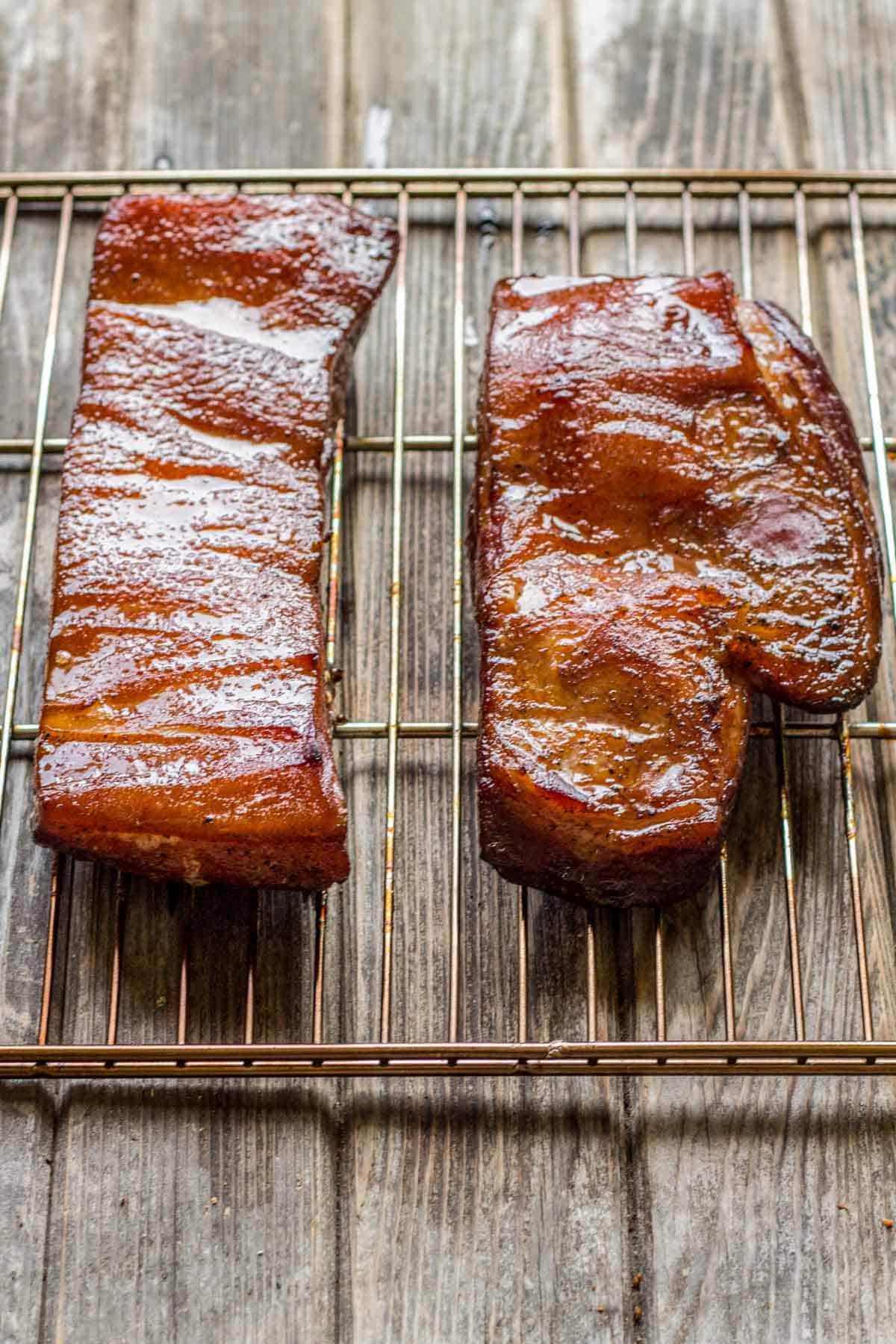
How to Store Smoked Bacon
Keep uncooked, sliced bacon tightly wrapped in plastic wrap in the fridge for up to 2 weeks. For longer storage, use a vacuum sealer or freezer bag and freeze for up to 6 months.
Once cooked, let it come to room temperature, then store leftovers in an airtight container in the fridge and enjoy within 4–5 days.
FAQs
Homemade bacon is typically made from higher quality pork and contains only the ingredients you choose. You can control the use of nitrites, artificial smoke flavor or natural seasonings. It’s dry-cured and smoked for deeper, more complex flavor. The texture is also noticeably different: homemade bacon is firmer, meatier, and more satisfying to chew, while store-bought bacon tends to be thinner, softer, and wetter due to the added moisture in commercial processing.
Yes, but you’ll lose the pink color and classic dry-cured bacon flavor. For food safety, the best thing is to follow a proper alternative curing method.
Yes, a smoker is a good idea if you want truly smoked flavorful bacon. It's special equipment, but you just can't get the same flavor from an oven. There are ways for a home cook to DIY a smoker that you can look up. You can add a teaspoon of liquid smoke to the cure if you don’t have one, but results will not be as good.
It depends. Thinner slices cook faster and get crispier. Thicker cuts feel meatier. Use a meat slicer for consistent results.
Did you LOVE this recipe? Please leave a star ⭐️ rating and comment and tag your creations @ColeyCooks on Instagram!
This post may contain affiliate links.
Want to Save This Recipe?
Enter your email & I'll send it to your inbox.
By submitting this form, you consent to receive emails from Coley Cooks.
Smoked Bacon Recipe
Ingredients
- ¼ cup Kosher salt
- 1 teaspoon pink curing salt
- ¼ cup brown sugar
- ¼ cup honey or maple syrup
- 1 tablespoon freshly cracked black pepper
- 5 lb pork belly skin and bones removed
- applewood chips for smoking
Instructions
- Combine the Kosher salt, pink curing salt, brown sugar, honey or maple syrup and black pepper in a large 2-gallon zip-top bag. Squish it around until it's all mixed together, then add the pork belly.
- Massage the mixture all over the belly, being sure to get it into every nook and cranny. Press the air out of the bag, seal it, and place in the refrigerator for one week. Be sure to check on it every day or so, giving it a brief massage and turing the bag over.
- After 7 days, the meat should feel firm to the touch. If it's still very soft, allow it to cure for another day or two. Remove the meat from the bag and rinse it well under cold water, then pat very dry with paper towels.
- Prepare a smoker with applewood chips and set it to 225°F.
- Smoke the pork belly for about 2-3 hours, until an instant-read thermometer reads 165 degrees. Allow to cool, then refrigerate overnight. The bacon will be easier to slice when cold.
- Use a long serrated knife to slice it however thick or thin you prefer, then cook just as you would store-bought bacon.
- Leftover uncooked bacon can be stored, wrapped tightly, in the refrigerator for up to 2 weeks, and in the freezer for up to 6 months.
Notes
- Always use precise measurements in your dry cure recipe, especially the sodium nitrite (pink curing salt).
- Rinse and pat the bacon completely dry before smoking for best results.
- Chill before slicing to make it easier, especially for the first time.
- If curing in bulk, label each slab of pork belly to track the curing period.


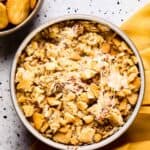


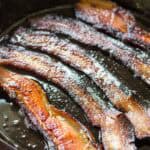
Very cool. I need to try this. I have an electric smoker that I recently used for the very first time. I smoked a whole leg of lamb and it was delish. Eager to try other things in the smoker.
Simple ingredients and easy, Delicious!!!!! Would eat it again!